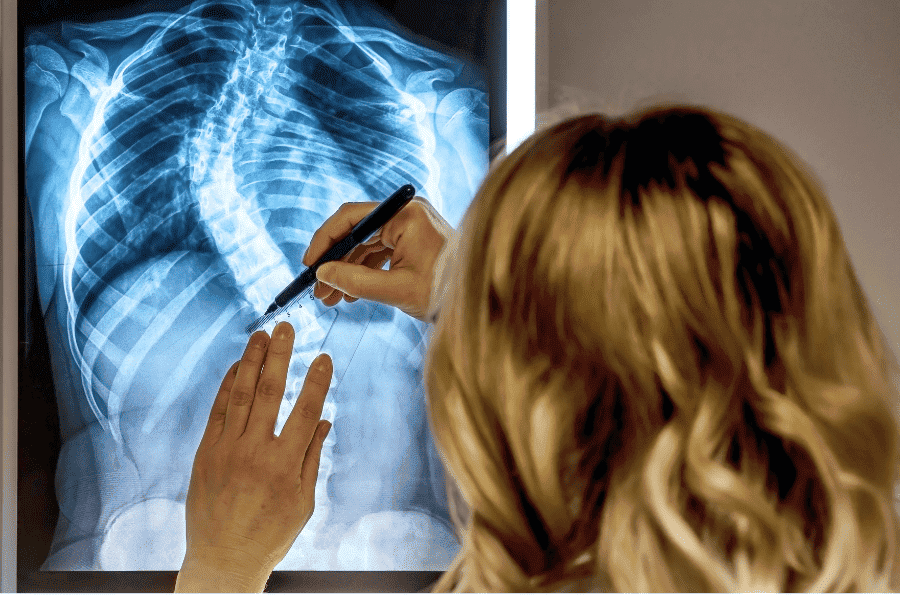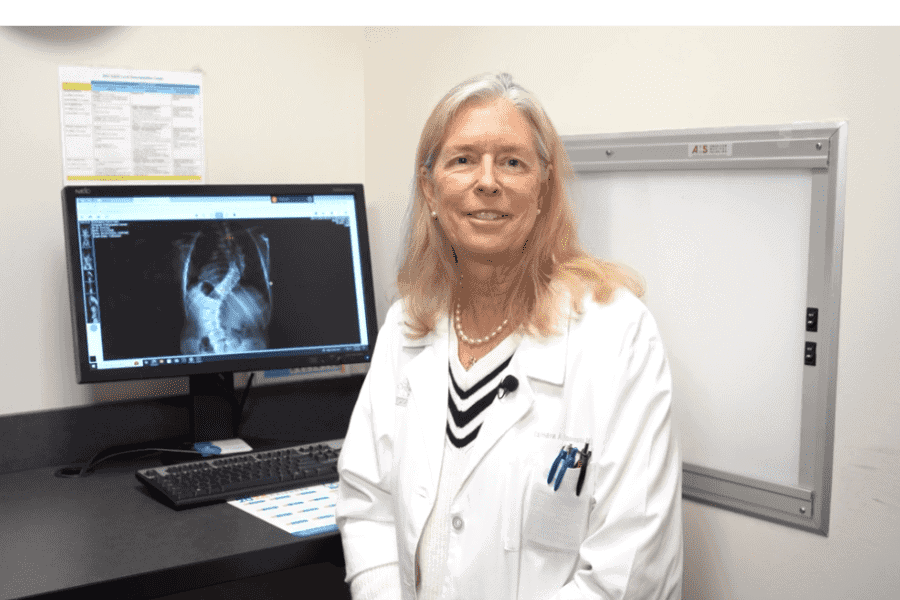Understanding Adolescent Scoliosis with Tamara A. Topoleski, M.D.
- What is Scoliosis?
- What is the Most Common Form of Adolescent Scoliosis?
- How is Adolescent Scoliosis Diagnosed?
Have you noticed your child has poor posture or ill-fitting clothes? Adolescent idiopathic scoliosis manifests as a distinct curvature of the spine during late childhood or adolescence, diverging from the typical straight growth pattern. This condition results in the spine developing a side-to-side curve, often forming an elongated “S” or “C” shape, with the vertebrae experiencing a slight twist or rotation.
Adolescent scoliosis disrupts the spine’s alignment, causing physical changes, movement challenges, and chronic pain rather than the commonly depicted perfectly aligned spine.
Addressing this prevalent yet often misunderstood condition, which affects 7 million people, including up to 5.1% of adolescents, requires looking at the causes and signs, especially when diagnosing adolescent scoliosis. Tamara A. Topoleski, M.D., a board-certified pediatric orthopaedic surgeon at Orlando Orthopaedic Center, shares what to look for if you think your child might have scoliosis.
What is Scoliosis?

“Scoliosis is not just about the curve; it’s about how it affects the individual’s daily life.” – Dr. Tamara Topoleski
Adolescent Scoliosis: The Most Common Form
Adolescent scoliosis is the most prevalent form of this condition, and recognizing the signs early can make a significant difference in management and treatment. Here are some common signs parents should look out for:
- Asymmetry in the shoulders
- Uneven waistline creases
- Discrepancies in hip alignment
- Clothes not fitting properly
How is Adolescent Scoliosis Diagnosed
Parents will usually notice a lopsided posture or ill-fitting clothes. You may be able to see or feel that the spine is curving abnormally.
Getting a confirmed diagnosis begins with a doctor’s initial assessment, often prompted by the visual cues and certain signs mentioned above. You can schedule a scoliosis screening.
Dr. Topoleski emphasizes the importance of the assessment while being careful not to expose children to radiation. However, scoliosis diagnosis may require x-rays, which provide a full-length view of the spine, from the neck down to the pelvis, critical for diagnosing scoliosis accurately.
What is the Outlook on Adolescent Scoliosis?
Studies show that early detection and treatment can improve outcomes for individuals with scoliosis. While adolescent scoliosis affects a considerable percentage of youth, advancements in treatment have led to successful management in many cases.
Seeking Help and Further Information
 Recognizing the signs of scoliosis is the first step toward getting the help needed. One scoliosis study revealed that the overall prevalence of screening positive among students was 3.9%, underlining the importance of screening programs to identify cases early for better outcomes
Recognizing the signs of scoliosis is the first step toward getting the help needed. One scoliosis study revealed that the overall prevalence of screening positive among students was 3.9%, underlining the importance of screening programs to identify cases early for better outcomes
The Orlando Orthopedic Center offers comprehensive resources and support for those seeking more information or needing to consult a specialist.
Next Steps: Should You Get Screened for Scoliosis?
Understanding scoliosis is the first step toward effective management and treatment. With early detection and care, individuals can lead healthy, active lives. Dr. Topoleski and the team at Orlando Orthopedic Center are dedicated to providing support and treatment options tailored to each patient’s unique needs.
“We’re here to help you navigate this journey with expertise, compassion, and personalized care.” – Dr. Tamara Topoleski
Remember, scheduling a screening could provide early detection and diagnosis if you or someone you know is showing signs of scoliosis.


